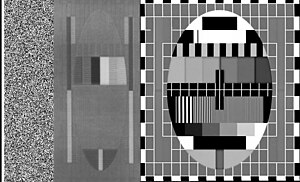
Analog television is the original television technology that uses analog signals to transmit video and audio. In an analog television broadcast, the brightness, colors and sound are represented by amplitude, phase and frequency of an analog signal.

NTSC is the first American standard for analog television, published in 1941. In 1961, it was assigned the designation System M. It is also known as EIA standard 170.

Phase Alternating Line (PAL) is a colour encoding system for analog television. It was one of three major analogue colour television standards, the others being NTSC and SECAM. In most countries it was broadcast at 625 lines, 50 fields per second, and associated with CCIR analogue broadcast television systems B, D, G, H, I or K. The articles on analog broadcast television systems further describe frame rates, image resolution, and audio modulation.

Standard-definition television is a television system that uses a resolution that is not considered to be either high or enhanced definition. Standard refers to offering a similar resolution to the analog broadcast systems used when it was introduced.

SECAM, also written SÉCAM, is an analog color television system that was used in France, Russia and some other countries or territories of Europe and Africa. It was one of three major analog color television standards, the others being PAL and NTSC. Like PAL, a SECAM picture is also made up of 625 interlaced lines and is displayed at a rate of 25 frames per second. However, due to the way SECAM processes color information, it is not compatible with the German PAL video format standard. This page primarily discusses the SECAM colour encoding system. The articles on broadcast television systems and analog television further describe frame rates, image resolution, and audio modulation. SECAM video is composite video because the luminance and chrominance are transmitted together as one signal.

Digital Video Broadcasting (DVB) is a set of international open standards for digital television. DVB standards are maintained by the DVB Project, an international industry consortium, and are published by a Joint Technical Committee (JTC) of the European Telecommunications Standards Institute (ETSI), European Committee for Electrotechnical Standardization (CENELEC) and European Broadcasting Union (EBU).

Composite video is an analog video format that typically carries a 525 or 625 line signal on a single channel, unlike the higher-quality S-Video and the even higher-quality component video.
Broadcasttelevision systems are the encoding or formatting systems for the transmission and reception of terrestrial television signals.
Near Instantaneous Companded Audio Multiplex (NICAM) is an early form of lossy compression for digital audio. It was originally developed in the early 1970s for point-to-point links within broadcasting networks. In the 1980s, broadcasters began to use NICAM compression for transmissions of stereo TV sound to the public.
HD-MAC was a broadcast television standard proposed by the European Commission in 1986, as part of Eureka 95 project. It belongs to the MAC - Multiplexed Analogue Components standard family. It is an early attempt by the EEC to provide High-definition television (HDTV) in Europe. It is a complex mix of analogue signal, multiplexed with digital sound, and assistance data for decoding (DATV). The video signal was encoded with a modified D2-MAC encoder.
Television encryption, often referred to as scrambling, is encryption used to control access to pay television services, usually cable, satellite, or Internet Protocol television (IPTV) services.

Multiplexed Analogue Components (MAC) was an analog television standard where luminance and chrominance components were transmitted separately. This was an evolution from older color TV systems where there was interference between chrominance and luminance.
Zweikanalton or A2 Stereo, is an analog television sound transmission system used in Germany, Austria, Australia, Switzerland, Netherlands and some other countries that use or used CCIR systems. South Korea utilized a modified version of Zweikanalton for the NTSC analog television standard. It relies on two separate FM carriers.
Analog high-definition television has referred to a variety of analog video broadcast television systems with various display resolutions throughout history.
MUSE, commercially known as Hi-Vision was a Japanese analog high-definition television system, with design efforts going back to 1979.

In television electronics, A-MAC carries digital information: sound, and data-teletext on an FM subcarrier at 7 MHz. Since the vision bandwidth of a standard MAC signal is 8.4 MHz, the horizontal resolution on A-MAC has to be reduced to make room for the 7 MHz carrier. A-MAC has not been used in service.

C-MAC is the television technology variant approved by the European Broadcasting Union (EBU) for satellite transmissions. The digital information is modulated using 2-4PSK, a variation of quadrature PSK where only two of the phaser angles (±90°) are used.

Among the family of MAC or Multiplexed Analogue Components systems for television broadcasting, D-MAC is a reduced bandwidth variant designed for transmission down cable.

D2-MAC is a satellite television transmission standard, a member of Multiplexed Analogue Components family. It was created to solve D-MAC's bandwidth usage by further reducing it, allowing usage of the system on cable and satellite broadcast. It could carry four high quality sound channels or eight lower quality audio channels. It was adopted by Scandinavian, German and French satellite broadcasts. The system was used until July 2006 in Scandinavia and until the mid-1990s for German and French sound channels.

CCIR System B was the 625-line VHF analog broadcast television system which at its peak was adopted by more than one hundred countries, either with PAL or SECAM colour. It is usually associated with CCIR System G for UHF broadcasts.








